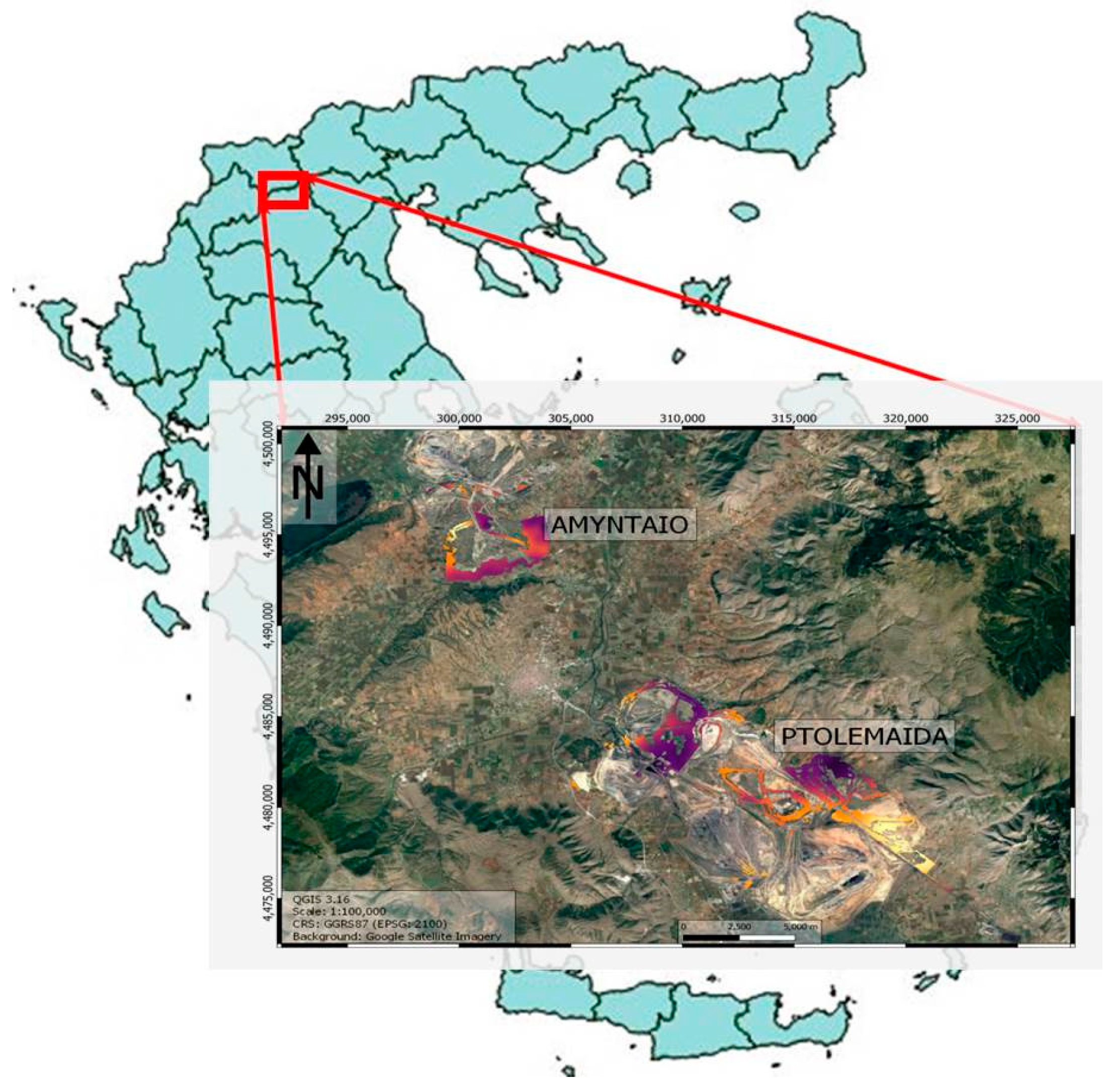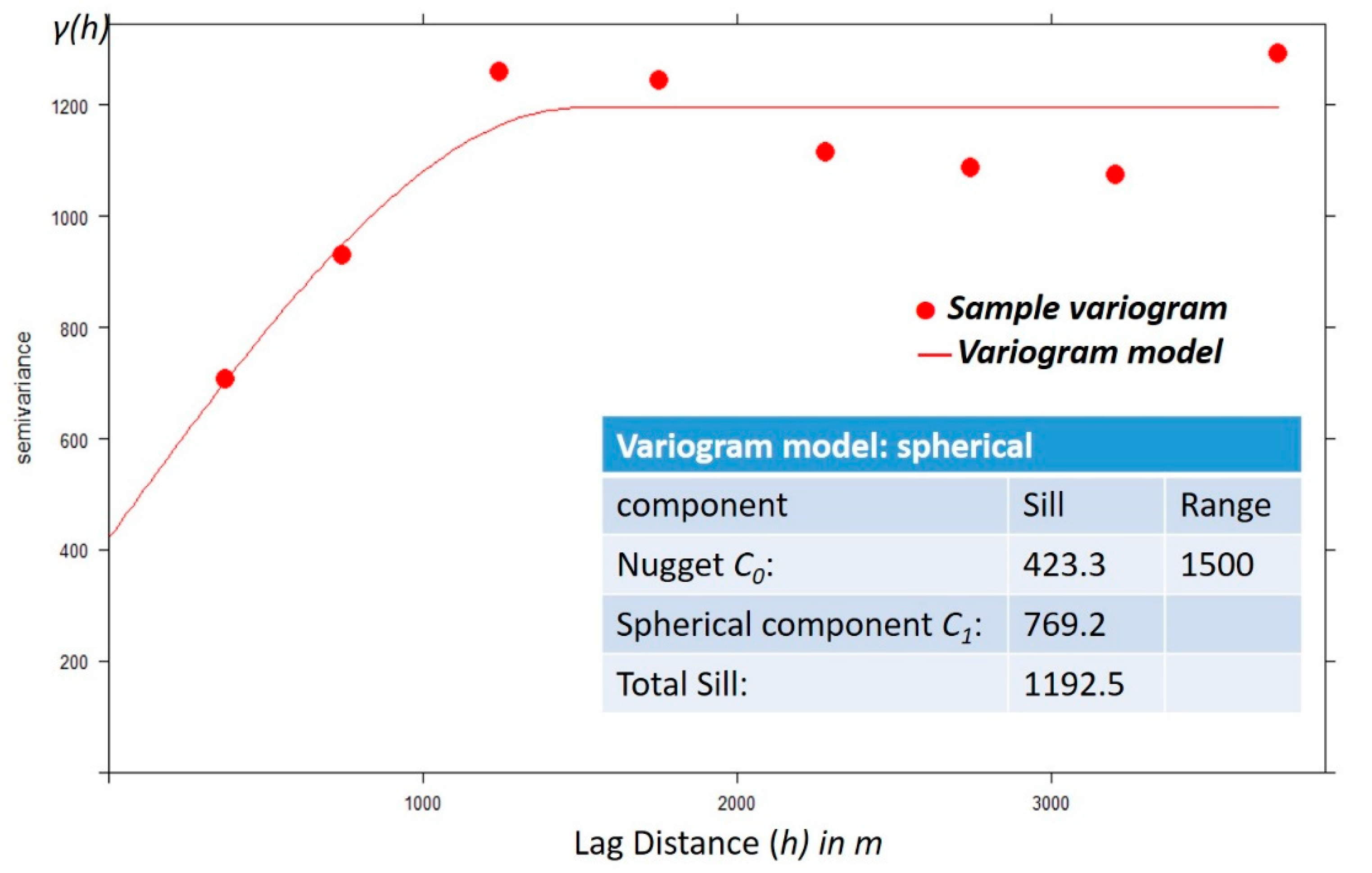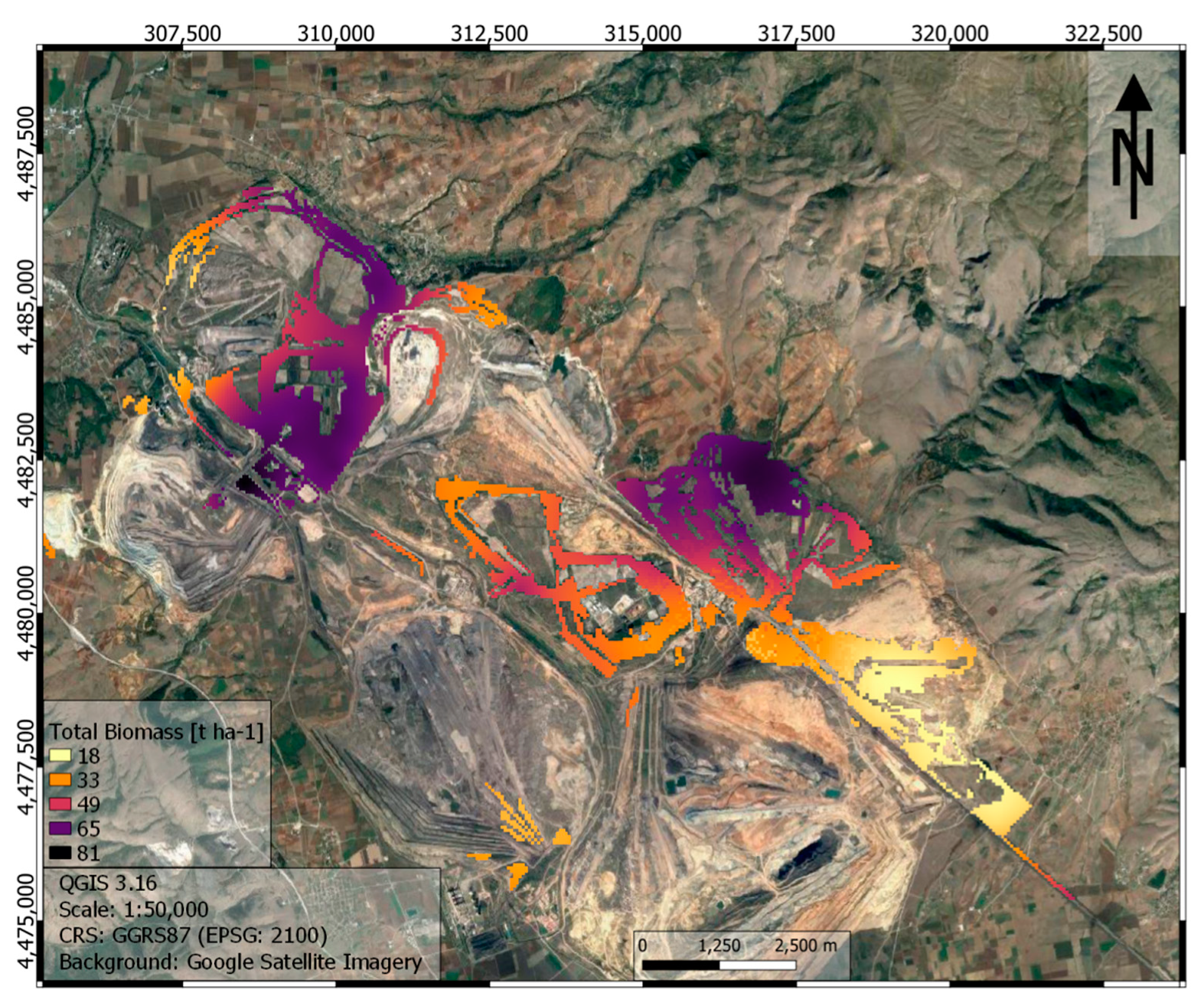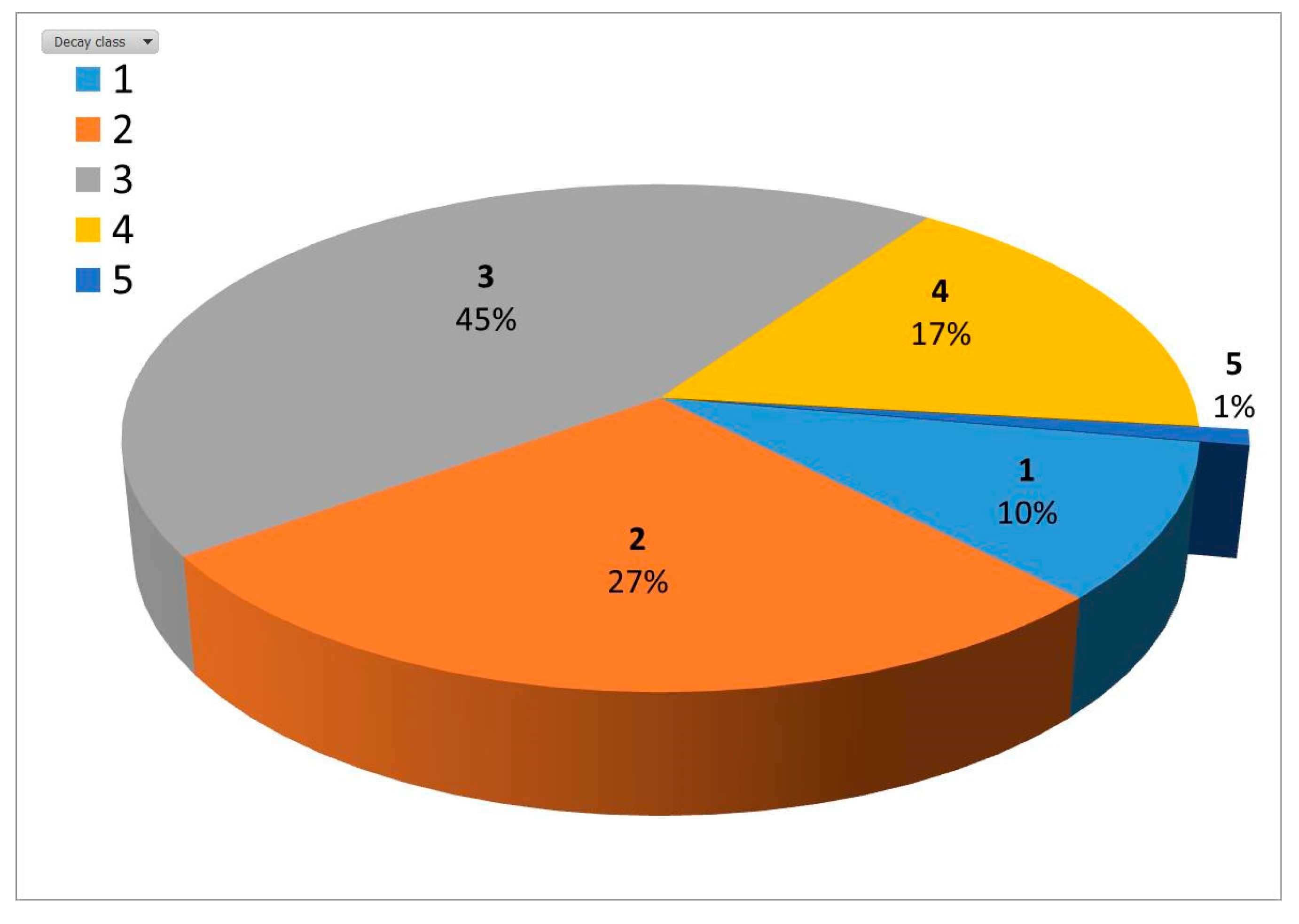Assessing Black Locust Biomass Accumulation in Restoration Plantations
Abstract
1. Introduction
2. Materials and Methods
2.1. Study Area
2.2. Inventory Data
2.3. Above Ground Biomass Estimation
2.4. Statistical Analysis
3. Results
3.1. Amyntaio Mine Field
3.2. Ptolemaida Mine Field
3.3. Standing and Lying Dead Wood
4. Discussion
5. Conclusions
Author Contributions
Funding
Institutional Review Board Statement
Informed Consent Statement
Data Availability Statement
Acknowledgments
Conflicts of Interest
References
- Kumar, L.; Mutanga, O. Remote Sensing of Above-Ground Biomass. Remote. Sens. 2017, 9, 935. [Google Scholar] [CrossRef]
- Grassi, G.; House, J.; Dentener, G.G.F.; Federici, S.; Elzen, M.D.; Penman, J. The key role of forests in meeting climate targets requires science for credible mitigation. Nat. Clim. Chang. 2017, 7, 220–226. [Google Scholar] [CrossRef]
- TSVCM. Taskforce on Scaling Voluntary Carbon Markets; Final Report. 2021. Available online: https://www.iif.com/Portals/1/Files/TSVCM_Report.pdf (accessed on 27 October 2021).
- Tong, X.; Brandt, M.; Yue, Y.; Ciais, P.; Jepsen, M.R.; Penuelas, J.; Wigneron, J.-P.; Xiao, X.; Song, X.-P.; Horion, S.; et al. Forest management in southern China generates short term extensive carbon sequestration. Nat. Commun. 2020, 11, 1–10. [Google Scholar] [CrossRef] [PubMed]
- Pecchi, M.; Marchi, M.; Burton, V.; Giannetti, F.; Moriondo, M.; Bernetti, I.; Bindi, M.; Chirici, G. Species distribution modelling to support forest management. A literature review. Ecol. Model. 2019, 411, 108817. [Google Scholar] [CrossRef]
- Nicolescu, V.-N.; Rédei, K.; Mason, W.L.; Vor, T.; Pöetzelsberger, E.; Bastien, J.-C.; Brus, R.; Benčat, T.; Đodan, M.; Cvjetkovic, B.; et al. Ecology, growth and management of black locust (Robinia pseudoacacia L.), a non-native species integrated into European forests. J. For. Res. 2020, 31, 1081–1101. [Google Scholar] [CrossRef]
- Peabody, F.J. A 350-Year-Old American Legume in Paris. Castanea 1982, 47, 99–104. Available online: http://www.jstor.org/stable/4033219 (accessed on 6 November 2020).
- Arianoutsou, M.; Bazos, I.; Delipetrou, P.; Kokkoris, Y. The alien flora of Greece: Taxonomy, life traits and habitat preferences. Biol. Invasions 2010, 12, 3525–3549. [Google Scholar] [CrossRef]
- Dini-Papanastasi, O.; Arianoutsou, M.; Papanastasis, V.P. Robinia pseudoacacia L.: A dangerous invasive alien or a useful multi-purpose tree species in the Mediterranean environment? In Ecology, Conservation & Management of Mediterranean Climate Ecosystems, Proceedings of the 10th MEDECOS Conference, Rhodes, Greece, 25 April–1 May 2004; Arianoutsou, M., Papanastasis, V.P., Eds.; Millpress: Rotterdam, The Netherlands, 2004; pp. 42–59. [Google Scholar]
- Sitzia, T.; Cierjacks, A.; de Rigo, D.; Caudullo, G. Robinia pseudoacacia in Europe: Distribution, habitat, usage and threats. In European Atlas of Forest Tree Species; San-Miguel-Ayanz, J., de Rigo, D., Caudullo, G., Houston Durrant, T., Mauri, A., Eds.; Publications Office of the EU: Luxembourg, 2016; p. e014e79+. [Google Scholar]
- Dorado-Liñán, I.; Piovesan, G.; Martínez-Sancho, E.; Gea-Izquierdo, G.; Zang, C.; Cañellas, I.; Castagneri, D.; Di Filippo, A.; Gutiérrez, E.; Ewald, J.; et al. Geographical adaptation prevails over species-specific determinism in trees’ vulnerability to climate change at Mediterranean rear-edge forests. Glob. Chang Biol. 2019, 25, 1296–1314. [Google Scholar] [CrossRef] [PubMed]
- Thurm, E.A.; Hernández, L.; Baltensweiler, A.; Ayan, S.; Rasztovits, E.; Bielak, K.; Zlatanov, T.M.; Hladnik, D.; Balic, B.; Freudenschuss, A.; et al. Alternative tree species under climate warming in managed European forests. For. Ecol. Manag. 2018, 430, 485–497. [Google Scholar] [CrossRef]
- Dyderski, M.; Paź-Dyderska, S.; Frelich, L.; Jagodziński, A.M. How much does climate change threaten European forest tree species distributions? Glob. Chang. Biol. 2017, 24, 1150–1163. [Google Scholar] [CrossRef]
- Puchałka, R.; Dyderski, M.K.; Vítková, M.; Sádlo, J.; Klisz, M.; Netsvetov, M.; Prokopuk, Y.; Matisons, R.; Mionskowski, M.; Wojda, T.; et al. Black locust (Robinia pseudoacacia L.) range contraction and expansion in Europe under changing climate. Glob. Chang. Biol. 2020, 27, 1587–1600. [Google Scholar] [CrossRef]
- Klisz, M.; Puchałka, R.; Netsvetov, M.; Prokopuk, Y.; Vítková, M.; Sádlo, J.; Matisons, R.; Mionskowski, M.; Chakraborty, D.; Olszewski, P.; et al. Variability in climate-growth reaction of Robinia pseudoacacia in Eastern Europe indicates potential for acclimatisation to future climate. For. Ecol. Manag. 2021, 492, 119194. [Google Scholar] [CrossRef]
- Keskin, T.; Makineci, E. Some soil properties on coal mine spoils reclaimed with black locust (Robinia pceudoacacia L.) and umbrella pine (Pinus pinea L.) in Agacli-Istanbul. Environ. Monit. Assess. 2008, 159, 407–414. [Google Scholar] [CrossRef] [PubMed]
- Usuga, J.C.L.; Rodríguez-Toro, J.A.; Alzate, M.V.R.; Tapias, D.J.L. Estimation of biomass and carbon stocks in plants, soil and forest floor in different tropical forests. For. Ecol. Manag. 2010, 260, 1906–1913. [Google Scholar] [CrossRef]
- Brundu, G.; Pauchard, A.; Pyšek, P.; Pergl, J.; Brunori, A.; Canavan, S.; Campagnaro, T.; Celesti-Grapow, L.; de Sá Dechoum, M.; Dufour-Dror, J.-M.; et al. Global guidelines for the use of non-native trees: Awareness, sustainable use, invasion risk prevention and mitigation. NeoBiota 2020, 61, 65–116. [Google Scholar] [CrossRef]
- Vítková, M.; Sádlo, J.; Roleček, J.; Petřík, P.; Sitzia, T.; Müllerová, J.; Pyšek, P. Robinia pseudoacacia-dominated vegetation types of Southern Europe: Species composition, history, distribution and management. Sci. Total. Environ. 2019, 707, 134857. [Google Scholar] [CrossRef]
- Mantovani, D.; Veste, M.; Bohm, C.; Vignudelli, M.; Freese, D. Spatial and temporal variation of drought impact on black locust (Robinia pseudoacacia L.) water status and growth. iFor. Biogeosci. For. 2015, 8, 743–747. [Google Scholar] [CrossRef]
- De Gomez, T.; Wagner, M.R. Culture and Use of Black Locust. HortTechnology 2001, 11, 279–288. [Google Scholar] [CrossRef]
- Moshki, A.; Lamersdorf, N.P. Symbiotic nitrogen fixation in black locust (Robinia pseudoacacia L.) seedlings from four seed sources. J. For. Res. 2011, 22, 689–692. [Google Scholar] [CrossRef]
- Liu, Z.; Hu, B.; Bell, T.L.; Flemetakis, E.; Rennenberg, H. Significance of mycorrhizal associations for the performance of N2-fixing Black Locust (Robinia pseudoacacia L.). Soil Biol. Biochem. 2020, 145, 107776. [Google Scholar] [CrossRef]
- Cierjacks, A.; Kowarik, I.; Joshi, J.; Hempel, S.; Ristow, M.; von der Lippe, M.; Weber, E. Biological Flora of the British Isles: Robinia pseudoacacia. J. Ecol. 2013, 101, 1623–1640. [Google Scholar] [CrossRef]
- Vítková, M.; Müllerová, J.; Sádlo, J.; Pergl, J.; Pyšek, P. Black locust (Robinia pseudoacacia) beloved and despised: A story of an invasive tree in Central Europe. For. Ecol. Manag. 2016, 384, 287–302. [Google Scholar] [CrossRef]
- Papachristou, T.G.; Platis, P.D.; Papachristou, I.; Samara, T.; Spanos, I.; Chavales, E.; Bataka, A. How the structure and form of vegetation in a black locust (Robinia pseudoacacia L.) silvopastoral system influences tree growth, forage mass and its nutrient content. Agrofor. Syst. 2020, 94, 2317–2330. [Google Scholar] [CrossRef]
- Ministry of Rural Development and Food. Forestry Activities from Third Framework Program Funding, Regional Operational Programmers and National Funds for the Year 2004; Ministry of Rural Development and Food: Athens, Greece, 2004; p. 78.
- Brown, S. Estimating Biomass and Biomass Change of Tropical Forests: A Primer; FAO Forestry Paper 134; Food and Agriculture Organization of the United Nations: Rome, Italy, 1997; p. 55. [Google Scholar]
- Kim, T.J.; Bronson, P.B.; Wijaya, A. Spatial interpolation of above-ground biomass in labanan concession forest in east kalimantan, Indonesia. Math. Comput. For. Nat. Res. Sci. 2016, 8, 27–39. [Google Scholar]
- Theofanous, N.; Chrysafis, I.; Mallinis, G.; Domakinis, C.; Verde, N.; Siahalou, S. Aboveground Biomass Estimation in Short Rotation Forest Plantations in Northern Greece Using ESA’s Sentinel Medium-High Resolution Multispectral and Radar Imaging Missions. Forests 2021, 12, 902. [Google Scholar] [CrossRef]
- Chen, Q.; McRoberts, R.E.; Wang, C.; Radtke, P.J. Forest aboveground biomass mapping and estimation across multiple spatial scales using model-based inference. Remote. Sens. Environ. 2016, 184, 350–360. [Google Scholar] [CrossRef]
- Mitchard, E.T.A.; Feldpausch, T.R.; Brienen, R.J.W.; Lopez-Gonzalez, G.; Monteagudo, A.; Baker, T.R.; Lewis, S.L.; Lloyd, J.; Quesada, C.A.; Gloor, M.; et al. Markedly divergent estimates of Amazon Forest carbon density from ground plots and satellites. Glob. Ecol. Biogeogr. 2014, 23, 935–946. [Google Scholar] [CrossRef] [PubMed]
- World Bank. Assessment of Innovative Technologies and Their Readiness for Remote Sensing-Based Estimation of Forest Carbon Stocks and Dynamics; World Bank: Washington, DC, USA, 2021. [Google Scholar] [CrossRef]
- Sales, M.H.; Souza, C.M.; Kyriakidis, P.; Roberts, D.A.; Vidal, E. Improving spatial distribution estimation of forest biomass with geostatistics: A case study for Rondônia, Brazil. Ecol. Model. 2007, 205, 221–230. [Google Scholar] [CrossRef]
- Li, Y.; Li, M.; Liu, Z.; Li, C. Combining Kriging Interpolation to Improve the Accuracy of Forest Aboveground Biomass Estimation Using Remote Sensing Data. IEEE Access 2020, 8, 128124–128139. [Google Scholar] [CrossRef]
- Paletto, A.; Tosi, V. Deadwood density variation with decay class in seven tree species of the Italian Alps. Scand. J. For. Res. 2010, 25, 164–173. [Google Scholar] [CrossRef]
- Zianis, D.; Spyroglou, G.; Tiakas, E.; Radoglou, K. Bayesian and classical models to predict aboveground tree biomass allometry. For. Sci. 2016, 62, 247–259. [Google Scholar] [CrossRef]
- R Development Core Team. A Language and Environment for Statistical Computing; R Foundation for Statistical Computing: Vienna, Austria, 2020; Available online: http://www.rproject.org/ (accessed on 6 September 2020).
- Ribeiro, P.J., Jr.; Diggle, P.J. geoR: A package for geostatistical analysis. R-NEWS 2001, 1, 15–18. [Google Scholar]
- Dale, M.R.T.; Fortin, M.J. Spatial Analysis: A Guide for Ecologists; Cambridge University Press: Cambridge, UK, 2005; p. 365. [Google Scholar]
- Du, H.; Zhou, G.; Fan, W.; Ge, H.; Xu, X.; Shi, Y.; Fan, W. Spatial heterogeneity and carbon contribution of aboveground biomass of moso bamboo by using geostatistical theory. Plant Ecol. 2009, 207, 131–139. [Google Scholar] [CrossRef]
- Mallarino, A.P.; Wittry, D.J. Efficacy of Grid and Zone Soil Sampling Approaches for Site-Specific Assessment of Phosphorus, Potassium, pH, and Organic Matter. Precis. Agric. 2004, 5, 131–144. [Google Scholar] [CrossRef]
- Lamsal, S.; Rizzo, D.M.; Meentemeyer, R. Spatial variation and prediction of forest biomass in a heterogeneous landscape. J. For. Res. 2012, 23, 13–22. [Google Scholar] [CrossRef]
- Jaya, I.N.S. The Interpolation Method for Estimating the Above-Ground Biomass Using Terrestrial-Based Inventory. J. Manaj. Hutan Trop. 2014, 20, 121–130. Available online: https://journal.ipb.ac.id/index.php/jmht/article/view/8445 (accessed on 27 October 2021). [CrossRef]
- Akhavan, R.; Amiri, G.Z.; Zobeiri, M. Spatial variability of forest growing stock using geostatistics in the Caspian region of Iran. Caspian J. Environ. Sci. 2010, 8, 43–53. [Google Scholar]
- Rédei, K.; Gal, J.; Keserű, Z.; Antal, B. Above-Ground Biomass of Black Locust (Robinia pseudoacacia L.) Trees and Stands. Acta Silv. Lign. Hung. 2017, 13, 113–124. [Google Scholar] [CrossRef][Green Version]
- Wang, J.J.; Hu, C.X.; Bai, J.; Gong, C.M. Carbon sequestration of mature black locust stands on the Loess Plateau, China. Plant Soil Environ. 2016, 61, 116–121. [Google Scholar] [CrossRef]
- Lukić, S.; Pantić, D.; Simić, S.; Borota, D.; Tubić, B.; Djukic, M.; Djunisijević-Bojović, D. Effects of black locust and black pine on extremely degraded sites 60 years after afforestation—A case study of the Grdelica Gorge (Southeastern Serbia). iForest Biogeosci. For. 2016, 9, 235–243. [Google Scholar] [CrossRef]
- Dutta, R.K.; Agrawal, M. Restoration of opencast coal mine spoil by planting exotic tree species: A case study in dry tropical region. Ecol. Eng. 2003, 21, 143–151. [Google Scholar] [CrossRef]
- Filcheva, E.; Noustorova, M.; Gentcheva-Kostadinova, S.; Haigh, M. Organic accumulation and microbial action in surface coal-mine spoils, Pernik, Bulgaria. Ecol. Eng. 2000, 15, 1–15. [Google Scholar] [CrossRef]
- Carl, C.; Biber, P.; Landgraf, D.; Buras, A.; Pretzsch, H. Allometric Models to Predict Aboveground Woody Biomass of Black Locust (Robinia pseudoacacia L.) in Short Rotation Coppice in Previous Mining and Agricultural Areas in Germany. Forests 2017, 8, 328. [Google Scholar] [CrossRef]
- Woś, B.; Pająk, M.; Krzaklewski, W.; Pietrzykowski, M. Verifying the Utility of Black Locust (Robinia pseudoacacia L.) in the Reclamation of a Lignite Combustion Waste Disposal Site in Central European Conditions. Forests 2020, 11, 877. [Google Scholar] [CrossRef]
- Kraszkiewicz, A. Productivity of Black Locust (Robinia pseudoacacia L.) Grown on a Varying Habitats in Southeastern Poland. Forests 2021, 12, 470. [Google Scholar] [CrossRef]







| Parameter | N (tress ha−1) | dbh (cm) | Ht (m) | Hlc (m) | BA (1) (m2 ha−1) | AGBinv (2) (t ha−1) | AGBkrig (3) (t ha−1) |
|---|---|---|---|---|---|---|---|
| Amyntaio (788,08 ha, ninv = 65, nkrig = 2631) | |||||||
| Mean | 1975 | 9.3 | 11.5 | 6.2 | 14.4 | 71.9 | 67.1 |
| Range | 800–3500 | 6.2–20.9 | 6.1–17.2 | 0.55–9.5 | 6.1–31.9 | 29.5–206.0 | 7.3–120.5 |
| SD | 590.2 | 2.3 | 2.3 | 1.8 | 4.6 | 28.1 | 19.3 |
| SE (±) | 78.2 | 0.31 | 0.31 | 0.24 | 0.61 | 3.73 | 0.38 |
| RSE (%) | 3.95 | 3.29 | 2.68 | 3.85 | 4.21 | 5.19 | 0.56 |
| Ptolemaida (1782.00 ha, ninv = 149, nkrig = 7088) | |||||||
| Mean | 2746 | 7.2 | 9.0 | 4.7 | 11.1 | 54.4 | 48.1 |
| Range | 300–30,078 | 1.4–22.3 | 2.5–16.9 | 0.14–9.9 | 0.25–43.6 | 0.74–274.7 | 17.5–81.3 |
| SD | 2896 | 3.5 | 3.1 | 2.5 | 6.8 | 39.8 | 16.7 |
| SE (±) | 259.0 | 0.32 | 0.28 | 0.22 | 0.61 | 3.56 | 0.20 |
| RSE (%) | 9.43 | 4.4 | 3.08 | 4.7 | 5.5 | 6.55 | 0.41 |
| Whole study site (2570.08 ha, n = 214) | |||||||
| Mean | 2505 | 7.9 | 9.8 | 5.2 | 12.1 | 59.9 | |
| Range | 300–30,078 | 1.4–22.3 | 2.5–17.2 | 0.14–9.9 | 0.25–43.6 | 0.74–274.7 | |
| SD | 2445.9 | 3.4 | 3.1 | 2.4 | 6.4 | 37.4 | |
| SE (±) | 181.3 | 0.25 | 0.23 | 0.18 | 0.47 | 2.77 | |
| RSE (%) | 7.23 | 3.16 | 2.35 | 3.42 | 3.90 | 4.63 | |
| Min | Max | Mean | SD | ME | RMSE | |
|---|---|---|---|---|---|---|
| Amyntaio | ||||||
| Observed data | 29.5 | 206.0 | 74.84 | 29.2 | ||
| Kriging predictions | 49.0 | 109.3 | 75.22 | 12.5 | −0.383 | 28.77 |
| Ptolemaida | ||||||
| Observed data | 0.74 | 275.4 | 57.08 | 41.3 | ||
| Kriging predictions | 14.9 | 100.4 | 57.34 | 20.7 | −0.267 | 38.58 |
| Parameter | Lying Dead Wood 1 (m3 ha−1) | Lying Dead Wood 2 (t ha−1) | Standing Dead Wood (t ha−1) | Live Wood (t ha−1) |
|---|---|---|---|---|
| Amyntaio (n = 65) | ||||
| Mean | 5.2 | 1.6 (2.2%) | 4.4 (6.2%) | 71.9 |
| Range | 0.5–19.4 | 0.14 (0.5%)–6.9 (3.3%) | 0.40 (1.4%)–17.2 (8.3%) | 29.5–206.0 |
| SD | 5.1 | 1.7 | 4.0 | 28.1 |
| SE (±) | 1.0 | 0.33 | 0.65 | 3.7 |
| RSE (%) | 19.4 | 20.4 | 14.7 | 5.2 |
| Ptolemaida (n = 149) | ||||
| Mean | 9.3 | 2.9 (5.3%) | 4.5 (8.3%) | 54.4 |
| Range | 0.5–88.2 | 0.16 (22.8%)–28.2 (10.3%) | 0.1 (14.3%)–26.8 (9.8%) | 0.7–274.7 |
| SD | 15.2 | 5.1 | 4.7 | 39.9 |
| SE (±) | 1.9 | 0.65 | 0.54 | 3.6 |
| RSE (%) | 20.9 | 22.1 | 12.2 | 6.6 |
| Whole study site (n = 214) | ||||
| Mean | 8.1 | 2.6 (4.3%) | 4.4 (7.3%) | 59.9 |
| Range | 0.5–88.2 | 0.14 (20.0%)–28.2 (10.3%) | 0.1 (14.3%)–26.8 (9.8%) | 0.7–274.7 |
| SD | 13.1 | 4.4 | 4.5 | 37.4 |
| SE (±) | 1.4 | 0.47 | 0.42 | 2.8 |
| RSE (%) | 17.4 | 18.4 | 9.5 | 4.6 |
Publisher’s Note: MDPI stays neutral with regard to jurisdictional claims in published maps and institutional affiliations. |
© 2021 by the authors. Licensee MDPI, Basel, Switzerland. This article is an open access article distributed under the terms and conditions of the Creative Commons Attribution (CC BY) license (https://creativecommons.org/licenses/by/4.0/).
Share and Cite
Spyroglou, G.; Fotelli, M.; Nanos, N.; Radoglou, K. Assessing Black Locust Biomass Accumulation in Restoration Plantations. Forests 2021, 12, 1477. https://doi.org/10.3390/f12111477
Spyroglou G, Fotelli M, Nanos N, Radoglou K. Assessing Black Locust Biomass Accumulation in Restoration Plantations. Forests. 2021; 12(11):1477. https://doi.org/10.3390/f12111477
Chicago/Turabian StyleSpyroglou, Gavriil, Mariangela Fotelli, Nikos Nanos, and Kalliopi Radoglou. 2021. "Assessing Black Locust Biomass Accumulation in Restoration Plantations" Forests 12, no. 11: 1477. https://doi.org/10.3390/f12111477
APA StyleSpyroglou, G., Fotelli, M., Nanos, N., & Radoglou, K. (2021). Assessing Black Locust Biomass Accumulation in Restoration Plantations. Forests, 12(11), 1477. https://doi.org/10.3390/f12111477









